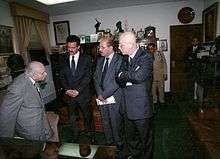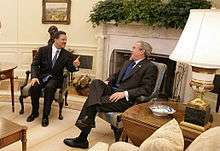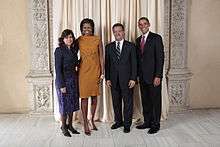Leonel Fernández
| Leonel Fernández | |
|---|---|
 | |
| 50th & 52nd President of the Dominican Republic | |
|
In office 16 August 2004 – 16 August 2012 | |
| Vice President | Rafael Alburquerque |
| Preceded by | Hipólito Mejía |
| Succeeded by | Danilo Medina |
|
In office 16 August 1996 – 16 August 2000 | |
| Vice President | Jaime David Fernández Mirabal |
| Preceded by | Joaquín Balaguer |
| Succeeded by | Hipólito Mejía |
| Personal details | |
| Born |
Leonel Antonio Fernández Reyna 26 December 1953 Santo Domingo, Dominican Republic |
| Political party | Liberation |
| Spouse(s) | Margarita Cedeño |
| Alma mater | Autonomous University of Santo Domingo |
| Signature |
 |
Leonel Antonio Fernández Reyna (![]() Pronunciation of "Leonel Fernández") (born 26 December 1953) is a Dominican lawyer, academic, and was President of the Dominican Republic from 1996 to 2000 and from 2004 to 2012. Since January 2016, he is the President of the EU-LAC Foundation.[1]
Pronunciation of "Leonel Fernández") (born 26 December 1953) is a Dominican lawyer, academic, and was President of the Dominican Republic from 1996 to 2000 and from 2004 to 2012. Since January 2016, he is the President of the EU-LAC Foundation.[1]
Fernández became the first elected president of the Dominican Republic under his political party, the Dominican Liberation Party ("Partido de la Liberación Dominicana" in Spanish, PLD), although party founder Juan Bosch was also sworn in as president in 1963 after the first democratic elections held in roughly four decades in the country. Fernández's administrations have focused much on technological and infrastructural development and macroeconomic and monetary stability (no hyperinflationary crisis has occurred under Fernández and PLD administrations).
He is a native of Villa Juana, Distrito Nacional and lived for much of his childhood and early adulthood in New York City.
Early life
Fernandez is the son of José Antonio Fernández Collado and Yolanda Reyna Romero. His family moved to New York City in the United States. They lived most of the time in the Washington Heights neighborhood.[2] It has a dense neighborhood dominated by ethnic Dominicans.
After he finished high school, Fernandez returned to his country and started Law Studies in the Universidad Autonoma de Santo Domingo.[3] He joined the Dominican Liberation Party when it was founded in 1973 by former Dominican President Juan Bosch. He had left the Dominican Revolutionary Party (PRD) to create the new party. Fernández was known as a close pupil of Bosch. He accompanied him as a vice-presidential candidate in the 1994 presidential election.[3]
First presidential term (1996–2000)

The 1994 presidential election results, which resulted in a reelection of President Joaquín Balaguer, were widely opposed by runner-up opposition leader José Francisco Peña Gómez and his party. In the meantime, the international community rose their concerns on the tightening of the political tensions and fear the country was on the verge of a civil uprising. Upon an official agreement widely known as "Pact for Democracy" ("Pacto por la Democracia" in Spanish) a special election was scheduled for May 1996 and President Balaguer acceded to not run in this election as part of the arranged treaty.[4] PRSC opted to present Vice-President Jacinto Peynado as their candidate,[5] however PRSC supporters feared he wasn't properly endorsed by their historical leader, therefore creating a vast independent mass of electors.[4]
In the first-round election on 16 May 1996 Fernández received 38.9% of the votes in the first round achieving second place behind José Francisco Peña Gómez and PRD. Peynado obtained 15% of the votes, the lowest outcome in Balaguer's party history which initiated a long-term downfall. After 2010 Presidential election, PRSC lost briefly its official recognition as a majority party, but regained it after an alliance with PLD was announced by Leonel Fernández for 2010 mid-term elections, in where both parties achieved 100% of Senate positions and obtained over 2/3 of the seats on the Chamber of Deputies. In the run-off election, held on 30 June 1996, the "Patriotic Front" integrated, and Fernández thus secured 51.2% of the votes to win the election. He was sworn in as President on 16 August 1996, succeeding Balaguer.
During his term in office, Fernández's political agenda was one of economic and critical reform. He helped enhance Dominican participation in hemispheric forums, such as the Organization of American States and the Summit of the Americas. The Dominican economy enjoyed an average growth rate of seven percent, the highest in Latin America for that period, and was among the highest in the world along with South Korea's and People's Republic of China. Inflation was stabilized in the low single digits, also among the lowest of Latin America.
Fernández also began a very personal and visionary plan to run the Dominican Republic. When developers proposed the country's first modern port during his first term, he said that "We could be the Singapore of the Caribbean".[6] In Santo Domingo and Santiago, which comprised 40% of the country population, he favored then-called "mega-projects", his government built numerous highways and tunnels which improved transit across the greater extent of these cities and created OMSA (Metropolitan Office of Autobus Services in English). Also gave incentives for foreign direct investment.
In 2000, Fernández was unable to run for a consecutive term as the 1994 constitution did not allow it. His party held primaries to elect a presidential nominee, which were won by Danilo Medina with 52% of the votes against Vice-President Jaime David Fernández Mirabal.[7] Medina, who was sworn as the PLD candidate for the 2000 presidential election,[8] was defeated by the PRD candidate, Hipólito Mejía.[9] Mejia did not satisfy the 50% rule to avoid a feared run-off election, but Balaguer, who placed second, recognized Mejia's win immediately.[10]
Second presidential term (2004–2008)

Fernández was elected to a second term of office in the presidential election held on 16 May 2004 with an absolute majority and the second highest percentage ever in Dominican history (57%). He was sworn in on 16 August 2004. His victory was due in large part to the collapse of the Dominican economy. This collapse has been attributed to skyrocketing oil prices and a slumping international economy post-9/11, excessive borrowing under the Mejía administration and the failure of three banks in the country: Banco Intercontinental (Baninter), Bancrédito and Banco Mercantil. In an effort to avoid further economic chaos, the Mejía administration effectively underwrote all three banks, repaying their customers but generating even greater public debt. Some of the bankers involved have been or are on trial, yet the extent of their fraud is hard to measure as their widespread largess with officials within both the Fernández and Mejía administrations has made it nearly impossible to achieve a true accounting of what conditions led to the banks's demise.
According to local sociologist José Oviedo, "The country trusts him with the economy, but he does not seem to pay that much attention to social issues." Economic prosperity, which his government boasts of, doesn't seem to reach enough people.[6] According to the Wall Street Journal, [11] the economy situation worsen during his last term.
Presidential elections 2008

During the Mejía administration, the constitution was changed to again allow the immediate re-election of presidents. Although Mejía was ultimately unsuccessful in his bid for re-election, this opened the door for Fernández to attempt a similar run. On 7 May 2007, despite great controversy over whether the PLD party should support the concept of re-election, Fernández won the PLD primary election with a 72% voting percentage against his former Chief of Staff and confidant, Danilo Medina.
As a result, Fernández became the official PLD candidate for the presidency in the May 2008 General Election.
Fernández was declared the victor of the 2008 election, defeating six others, including the PRD candidate and former president Mejía's right-hand man, Miguel Vargas, and the PRSC's candidate, Amable Aristy. Fernández defeated Vargas 53% to 41%.[12] Vargas accepted the defeat the same day, 16 May.[13] Fernández was sworn in for his third term on 16 August 2008, with the traditional ceremony at the National Congress.[14]
Family and personal life
Fernández married for the first time to Rocío Domínguez Quezada in 1987 (the daughter of Juan Domínguez and the mayoress of Jarabacoa Josefa Piedad Quezada), and had two children: Omar and Nicole. They divorced in 1996.[15][16] In 2003, Fernández married Margarita Cedeño Lizardo, his former Presidential Legal Adviser and an associate attorney of his law firm, and had one child: Yolanda América María.[17][18]
In addition to Spanish, his mother tongue, Fernández is fluent in English and French.[19]
See also
References
- ↑ "EU- LAC Foundation: Former President of Dominican Republic Leonel Fernandez will chair Bi-regional Foundation". Ministerio de Relaciones Exteriores y Movilidad Humana de Ecuador. Retrieved 19 September 2016.
- ↑ FOX News Network (25 February 2011). "Leonel Fernández Urges Bicultural Youth to Connect With Dominican Republic". Fox News. Archived from the original on 4 May 2011. Retrieved 4 August 2011.
- 1 2 COPDES. "Dr. Leonel Fernández" (PDF) (in Spanish). Retrieved 4 August 2011.
- 1 2 Morgan, Jana and Espinal, Rosario (2006) Cultura política de la democracia en la República Dominicana. p. 3.
- ↑ Grullón, Sandino (2006) Historia electoral dominicana : siglo XX 1900–2004. Imp. Servicios Gráficos Tito. ISBN 8495119226.
- 1 2 Stier, Ken (16 April 2006) Tropical Paradox, Time.com
- ↑ DR1 (29 June 1999). "More on the PLD presidential candidate". Retrieved 20 September 2011.
- ↑ laverdad.es (26 June 2011). "Medina, un estratega pragmático, vuelve a ser candidato presidencial del PLD" (in Spanish). Retrieved 20 September 2011.
- ↑ Los Angeles Times (19 May 2000). "Populist Is Winner of Presidential Race". Retrieved 20 September 2011.
- ↑ The New York Times (19 May 2000). "Dominican Wins Presidency As Opponent Shuns Runoff". Retrieved 20 September 2011.
- ↑ Mary Anastasia O'Grady (25 November 2012) The Dominican Republic's Taxing Turn, the Wall Street Journal
- ↑ Reuters (17 May 2008). "Election propels Dominican president to third term". Retrieved 29 September 2010.
- ↑ Diario Libre. "Miguel Vargas reconoce su derrota" (in Spanish). Retrieved 29 September 2010.
- ↑ "Dominican president sworn in for third term", Xinhua (People's Daily Online), 17 August 2008.
- ↑ http://www.elcaribe.com.do/2016/09/23/fallece-abuelo-omar-nicole-fernandez
- ↑ http://acentoinformativo.com/lamentable-fallece-abuelo-los-hijos-del-ex-presidente-leonel-fernandez-mira-quien/
- ↑ http://www.diariolibre.com/revista/margarita-le-dedica-algunas-palabras-a-leonel-por-su-aniversario-de-bodas-GK2693181
- ↑ http://www.listindiario.com/la-republica/2016/07/17/427370/quien-sera-margarita-danilo-o-leonel
- ↑ http://www.funglode.org/biografia-dr-fernandez/
External links
- Biography
- Biography at CIDOB Foundation (Spanish)
- Appearances on C-SPAN
- Works by or about Leonel Fernández in libraries (WorldCat catalog)
- "Leonel Fernández collected news and commentary". The New York Times.
| Wikimedia Commons has media related to Leonel Fernández. |
| Political offices | ||
|---|---|---|
| Preceded by Joaquín Balaguer |
President of the Dominican Republic 1996–2000 |
Succeeded by Hipólito Mejía |
| Preceded by Hipólito Mejía |
President of the Dominican Republic 2004–2012 |
Succeeded by Danilo Medina |